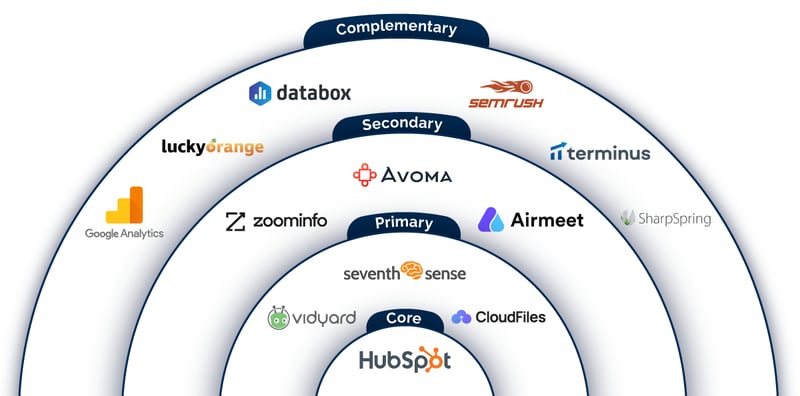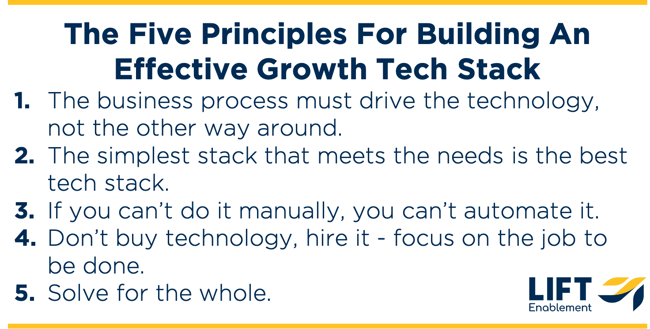
Editor's Note: This blog was originally published on July 23, 2020 and since has been updated to reflect changes and updates over the past few years.
I’m among the first and loudest to say that in today’s world of sales and marketing, technology sucks up far too much oxygen and is over-valued. That, however, does not mean that the technology you use, aka your tech stack, is not important. Properly designed and implemented, technology is a tremendous accelerator and force multiplier.
Properly designed and implemented is, of course, the challenge. Far too often, technology creates friction, even when its purpose is to remove it.
There are 5 principles we follow when designing a growth-focused tech stack:
- The business process must drive the technology, not the other way around.
- The simplest stack that meets the needs is the best tech stack. (This typically means that things being equal, the fewer number of apps the better.)
- If you can’t do it manually, you can’t automate it.
- Don’t buy technology, hire it; focus on the job to be done.
- Solve for the whole.

5 Essential Components of a High Sales Growth Tech Stack
One of the most common mistakes we see in virtually all aspects of the modern customer acquisition and success playbook is the tendency to jump right to its most advanced, complex aspects. This is particularly true when implementing or leveraging martech. I’ve lost count of the number of mid-market companies that have “implemented” some of the most advanced technology apps available, but still aren’t using their CRM in a consistent manner.
As I shared in a recent course I conducted for the Marketing AI Institute Academy, the companies that utilize technology the best are the ones who start small, then iterate and build.
When assessing your tech stack, we recommend you view your needs through four levels:
- Core: These are the must-have applications; you simply can’t function without these.
- Primary: These apps are key drivers & enablers, directly supporting crucial activities
- Secondary: These are good-to-great applications, enabling you to maximize your abilities in a crucial few areas
- Complementary: These apps fall into two categories:
a) helpful applications that are used to enable you to automate important activities (you’ll want to measure this category by time saved) or
b) applications that could be more central that you’re testing out.
Based upon our work with hundreds of companies in more than 30 industries, the following is the (ideal) tech stack we recommend for any mid-market company serious about utilizing technology to make growth easier.
What if you’re not a mid-market company? Start with the core applications and build your tech stack from there.
Core
Someone once told me that the 7-iron is the most important club in a golf bag. That if a good golfer were only allowed to use one club, they’d use the 7-iron. What’s more, if they’re really good, they would achieve 85-90% of what they achieve using all 14 clubs (the number of clubs officially allowed in a golfer’s bag during play).
Think of your core stack in the same way. The design and buildout of your core level is going to be responsible for 70-80% of your outcomes, so build it out well.
CRM Platform
A few years ago we had a problem. One of our first principles is that the simplest stack to get the job done is the best, but it was impossible to keep it simple and get the job done. Companies were forced to constantly make a wicked trade-off: simplicity vs. capability. As a company grew, the complexity and needs of their business ultimately required using at least 3 applications.
Much has changed over the last few years, and today companies don’t need to make that tradeoff.

Today, there’s simply no reason that a mid-market company can’t use HubSpot as a single, core application. I’m not going to lie here, while I’ve been a fan of HubSpot since their founding, and Lift has been a customer and partner since 2011, I’ve often expressed my concern that HubSpot is trying to be too many things, encouraging them to focus more on fewer things.
HubSpot has built an absolute powerhouse platform and has eliminated the trade-off. For mid-market companies, HubSpot is the only single database option; it'll never be something that gets a lot of headlines, but is a major component to eliminating friction in the process.
Our recommendation: HubSpot. For the reasons mentioned above.
Primary
Sales Acceleration & Engagement
Salespeople are spending less time selling as more demands are being placed on their plate. The job of this category is to automate the predictable, reduce the noise, and reduce the effort required from salespeople to do their jobs well. This is a very hot category today with at least five companies that I’m aware of who have raised more than $100 million in funding. On a side note, I think SDRs from these categories account for about 40% of the cold emails and calls I get.
Our recommendation: HubSpot. HubSpot’s Sales Hub provides breadth and depth that are unrivaled. To match the core functions provided, you’d need to use 2-5 applications. What makes this a no-brainer is the strength of HubSpot at the core.
Video
Video is becoming more important (and, candidly, more hyped) every day. I’m not going to say you can’t grow without video, but if you’re not intelligently using video, it’s going to be a lot harder (and more expensive).
 Our recommendation: Vidyard. Vidyard is a powerful video platform providing insights, dynamic actions and greater control so that you can leverage video content effectively. A big plus is that Vidyard has built a native application within HubSpot.
Our recommendation: Vidyard. Vidyard is a powerful video platform providing insights, dynamic actions and greater control so that you can leverage video content effectively. A big plus is that Vidyard has built a native application within HubSpot.
Email Deliverability
Email is a critical communication channel for sales, marketing and success teams alike. Communicating via email is also more challenging than ever. There is no “real estate” that is more overcrowded and competitive than your user’s email inbox. Getting into the inbox is a big challenge, but it’s not enough. You must get in at the right time. The blast-and-pray approach is not something serious-minded growth companies do anymore. You must be smarter.
 Our recommendation: SeventhSense. The vast majority of the people involved in growth for your company won’t even know that this application is there, but they will notice stronger engagement and insights with their emails. If you're serious about email (and if you’re serious about growth, you better be serious about email), you should be obsessing about deliverability and engagement. There’s no application that comes close to SeventhSense.
Our recommendation: SeventhSense. The vast majority of the people involved in growth for your company won’t even know that this application is there, but they will notice stronger engagement and insights with their emails. If you're serious about email (and if you’re serious about growth, you better be serious about email), you should be obsessing about deliverability and engagement. There’s no application that comes close to SeventhSense.
Document Management
Over the last few years, millennials are the first set of digital natives to move into core roles. That means the view of content and documents used throughout the entire customer journey has shifted a bit.
It's not new that this content is part of the sales process. What is new is the prioritization of the security and management of these documents, along with data tracking, which was previously pretty much non-existent.
Previously, there were several less than optimal options in the market. For example, while I obviously believe HubSpot is great in many other ways, its Documents tool really isn't robust enough to meet the true needs of document management and distribution.
 Our recommendation: CloudFiles. We began testing out CloudFiles a couple of years ago and found it enables integration with your existing document system, whether it’s SharePoint, Box, Google Drive, etc. CloudFiles allows you to create multiple versions or multiple links for the same document, so you can use a single document in multiple ways to drive and assess performance. It provides documents, security, and integrates seamlessly into HubSpot, Salesforce, and other CRMs.
Our recommendation: CloudFiles. We began testing out CloudFiles a couple of years ago and found it enables integration with your existing document system, whether it’s SharePoint, Box, Google Drive, etc. CloudFiles allows you to create multiple versions or multiple links for the same document, so you can use a single document in multiple ways to drive and assess performance. It provides documents, security, and integrates seamlessly into HubSpot, Salesforce, and other CRMs.
Secondary
Lead Intelligence & Augmentation
Today, you have to know more about a possible prospect before the first touch than ever before. Databases are bigger than ever, and most funnels are bulging with inertia. A primary cause of that is the inability to craft contextualized messages and actions to those in your database. List/database quality has always been important, and today, it’s absolutely crucial. To win, you must know more about your leads and you must know it earlier than ever. This is where lead intelligence and augmentation comes in.
 Our recommendation: ZoomInfo. There simply isn’t a provider that comes close to providing the breadth and depth of information they provide with the level of accuracy that’s only matched by personal, firsthand sourcing.
Our recommendation: ZoomInfo. There simply isn’t a provider that comes close to providing the breadth and depth of information they provide with the level of accuracy that’s only matched by personal, firsthand sourcing.
That said, here are a couple of warnings: While their core product (lead intelligence) is great, they seem to be broadening their portfolio of features to include sales automation, intent data, and more. We are not recommending ZoomInfo for those needs, and would advise caution if you are considering these features.
You'll also want to pay attention to data privacy regulations. There are a number of initiatives from different regulatory bodies and several could potentially affect ZoomInfo. Your geographic location may also matter, as regulatory bodies in different places will likely have different rules.
Conversational Intelligence
One of the last frontiers in data has been conversations, particularly the ones that salespeople have with customers and prospects. Today, it's increasingly viable and easy to not only capture that data through recordings, but make it actionable using transcriptions and artificial intelligence. Conversational intelligence can be used to streamline communication. It serves as a great training or coaching resource, as well as quality control.
Unquestionably, the category leader is Gong—but we’re not recommending it here because it has capabilities very, very few people—especially in sales—are actually in a position to use. What’s exciting is that there is a growing universe of good products in this category.
 Our recommendation: Avoma. It’s extremely easy to use and meets the needs of most companies. For example, it automatically records your calls and meetings. It also transcribes and summarizes them, enabling you to create scoring rubrics, account plans, and more. It integrates with your system to align and helps lift the administrative burden, although I think the real power is that, without a rep needing to do anything, your rate of adoption and utilization goes up. That means your CRM becomes a stronger, more powerful tool.
Our recommendation: Avoma. It’s extremely easy to use and meets the needs of most companies. For example, it automatically records your calls and meetings. It also transcribes and summarizes them, enabling you to create scoring rubrics, account plans, and more. It integrates with your system to align and helps lift the administrative burden, although I think the real power is that, without a rep needing to do anything, your rate of adoption and utilization goes up. That means your CRM becomes a stronger, more powerful tool.
Event Management
For the last decade, webinars have been the dominant bottom-funnel demand generation go-to play—but the last few years have seen a surge in more dynamic virtual events. That means the days of a WebEx or Zoom with a deck and a voiceover are no longer enough to make an impression. People expect more interactivity; they want to do more fun, cool things. If a company is serious about growth, its engagement and activation strategy must integrate consistent, ongoing events.
 Our recommendation: Airmeet. Their recently revamped and relaunched tool is easy-to-use yet flexible, providing marketers, sales reps, and executives with excellent insight into attendees’ use, engagement, and more. (Full disclosure: As I write this blog, we are working on a project with Airmeet, but that did not influence my recommendation.)
Our recommendation: Airmeet. Their recently revamped and relaunched tool is easy-to-use yet flexible, providing marketers, sales reps, and executives with excellent insight into attendees’ use, engagement, and more. (Full disclosure: As I write this blog, we are working on a project with Airmeet, but that did not influence my recommendation.)
Complementary
Dashboarding/Data Visualization
I love dashboards and visualization. At Lift, we firmly believe that how you measure, and how your report/present measures, is as important as what you measure (and what you measure is really important). This may lead you to wonder why I place this in the complementary section. The reason is simple - most companies aren’t utilizing the capabilities of their existing systems as well as they should, and would be served better by focusing there first.
 Our recommendation: Databox. Databox is easy to set up and use, and provides highly engaging charts, visualizations and dashboards that can be shared in a number of ways in real time. Their integrations are also strong. Before using Databox, you'd have to log into multiple tools to pull data and use a series of spreadsheets that were ugly, complex and disruptive to maintain.
Our recommendation: Databox. Databox is easy to set up and use, and provides highly engaging charts, visualizations and dashboards that can be shared in a number of ways in real time. Their integrations are also strong. Before using Databox, you'd have to log into multiple tools to pull data and use a series of spreadsheets that were ugly, complex and disruptive to maintain.
Ads and Retargeting
For many clients we work with, paid campaigns are a necessary evil. That’s because search and other traditional tactics used to work well—or at least well enough—but it’s now harder and harder and harder to get noticed. Compounding this, SEO has increasingly become an insider's game. To take advantage of those tactics, it's now not enough to just have nets. You need nets and bait—and that means developing pathways to nudge, create familiarity, and drive awareness and engagement even when prospects are not on your site. That means more creative and extensive uses of paid tactics. While it depends on your strategy, most companies serious about growth must have an ad and retargeting tool in their stacks.

![]() Our recommendation: We recommend either SharpSpring, for traditional retargeting and audience targeting, or Terminus, which dials into true account-based marketing and advertising.
Our recommendation: We recommend either SharpSpring, for traditional retargeting and audience targeting, or Terminus, which dials into true account-based marketing and advertising.
Analytics
The ability to qualitatively and quantitatively analyze your data is important to making data-informed decisions. There are several categories for analytics; here are our recommendations:
Website analytics: Google Analytics. This likely needs no explanation.


Visual Website Analytics: Lucky Orange. Read our review here.
SEO: SEMRush. SEMRush strikes a nice balance between the ease of use, interpretation, and power of the tool itself.
Customer Data Platform (CDP)
According to HubSpot’s Ultimate Guide to CDPs, a CDP is a software that aggregates and organizes customer data across a variety of touch-points and is used by other software, systems, and marketing efforts. CDPs collect and structure real-time data into individual, centralized customer profiles.
Our recommendation: If you’re not fully leveraging the tech stack I’ve laid out here, then don’t worry about a CDP at this point.

 Doug Davidoff
Doug Davidoff